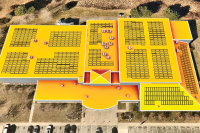Mine safety training saves a life
Wresting huge chunks of granite from a hillside is inherently dangerous work, but the safety training provided at one Waynesville quarry has seeped out from behind the stonewalls to benefit area citizens.
Opponents win concessions in first round of quarry permit fight
The state has delayed issuing a necessary permit and instead is asking Harrison Construction to provide a slew of additional information to ensure the expansion won’t create an environmental hazard or safety risk.
“They need to be more responsible. We felt that and we proved that,” said Suzanne Hendrix, one of dozens of neighbors who organized against the quarry. “It took a big effort on everyone’s part.”
From the impacts of blasting on drinking wells to the stability of its massive rock walls, the quarry must address a laundry list of concerns before the N.C. Division of Land Resources will entertain the expansion permit.
The quarry received a letter from the state in late June requesting additional information and has 180 days to reply. Judy Wehner, assistant state mining specialist, said she has no indication from the quarry when it might respond. The quarry did not return phone calls and emails seeking comment.
Neighbors of the quarry are optimistic, but also skeptical.
“Their track record isn’t good,” said Polly Leatherwood, 69, who has lived near the quarry her whole life. “If they do what they are supposed to, it would be fine.”
But state environmental inspectors visit too infrequently —with a lapses spanning more than two years by some agencies and four years by others — and aren’t diligent enough when they do, according to neighbors.
“They need to follow up on them and see they do what they say they are going to do. That’s the biggest thing,” said Leatherwood.
Ronnie Deweese agreed the state’s request for additional information won’t work unless regulatory oversight is ramped up going forward.
“They can provide all the information they want, but if they don’t have an inspection every so often it won’t do no good,” said Deweese, who lives near the quarry.
Shoring up quarry walls
The biggest issue the quarry must address is the stability of the quarry walls, which tower hundreds of feet in the air. Last year, a slab of rock hundreds of feet wide and tall came crashing down at the quarry. The potentially fatal slide could have been prevented had the quarry practiced more careful geotechnical monitoring, according to geologists and mine inspectors that visited the site in the aftermath.
But there are no state or federal engineering standards that apply to quarries, nor do state or federal agencies oversee the blasting and excavation plans. There are no rules limiting how steep or tall quarry walls can be.
In the new permit, however, the state took the quarry to task over its plans to stabilize and shore up the slide area.
Plans submitted by the quarry “contained insufficient information to assess the stability of rock soils and slopes,” according to the state’s letter. The quarry must provide more detailed engineering plans and slope assessments before the permit can proceed.
Quarries generally are not required to hire geotechnical engineers to monitor their operations, yet in this case, the state wants to see a slope expert on hand throughout the slide cleanup.
“Unexpected planes of weakness in the bedrock or other unexpected conditions may be discovered as work progresses,” the letter states.
Rick Wooten, a state geologist and mountain landslide expert based in Asheville, provided the engineering critique of the quarry’s plans on behalf of the state mining agency. Opinions of state geologists are not typically sought by the agency that grants quarry permits.
Wooten also pointed out that the rock being mined is not in fact pure granite, as claimed by the quarry in its permit. Wooten said the “metamorphized sedimentary and igneous rock in the pit is much more structurally complex,” which affects how it behaves.
In order to shore up the slide that destabilized a major part of the quarry, quarry officials say they must expand the current boundaries of the quarry. Their plans call for recontouring the sheer vertical walls of the quarry with a more gentle grade. To do so, they say it is necessary to shave off the ridgeline above the quarry.
The expansion would bring operations closer to the doorstep of the Lickstone community, prompting the opposition.
State wants more information
The state found the quarry’s application wasn’t thorough enough in some areas. The state deemed the sediment and erosion control plan insufficient to control runoff, for example.
Following complaints by neighbors about blasting, the state wants to see a blasting analysis and detailed monitoring plan by a qualified blasting expert — something it had not asked for before.
The state also alerted the quarry that it may be required to install an air quality monitor at the site to measure dust particles, which have been a chief source of complaints. Such a monitor has been required at a quarry site in Spruce Pine similarly accused by neighbors of excessive dust.
“If they set up a monitoring device, we would feel better about it,” Rogers said. “We would know then how much dust is getting transferred onto us. Right now it is hearsay. It is our word against them.”
The state also acted on concerns from neighbors who fear blasting could disrupt the flow of their springs or wells as the quarry inches closer to their homes. The quarry was asked to “provide proof” that the expansion of the quarry wouldn’t harms the springs and wells.
But Michael Rogers doesn’t know how they could provide that kind of assurance.
“It is a fragile system really,” Roger said. Aquifers in the mountains are notoriously hard to read, with veins of water running through the rocks like a maze. A jarring blasting could cause one of the veins to collapse and cut off a spring or well’s flow, Rogers said. Rogers said he wants something in writing from, the quarry that they will dig him a new well if his spring is disrupted.
At least two of the quarry’s neighbors believe that blasting compromised their wells. One suffers from discolored water that stains her laundry. Another had her well suddenly go dry following a week of blasting. Polly Leatherwood said her well didn’t diminish in volume slowly, but just went dry all of a sudden “like you turned the water off.”
Leatherwood called the quarry, and someone came to see her but told her she would have to prove it was their fault.
The state also sent the quarry back to the drawing board on safety fencing around the top of the quarry walls. A fencing plan was required as part of the original application, but the quarry asserted it was unnecessary.
“The heavily wooded, surrounding mountain makes inadvertent public access to the highwall area unlikely,” the quarry wrote.
The state apparently wasn’t satisfied. It has reiterated the need for fencing and told the quarry to draw up a plan.
A high school freshman, Hannah Parrott of Waynesville, had raised this issue during a public hearing on the quarry’s permit, pointing out the threat the unfenced highwalls pose to animals.
A couple of the state’s critques were a result of typos in the quarry’s application, like failing to put north arrows on its maps or listing different numbers for how many acres will be impacted with the expansion.
Deweese said it will likely be up to the neighbors of the quarry to keep the pressure on.
“We’re going to have to make them stay the way they ought to be because they have had the run of things so long,” Deweese said.
Quarry must improve sediment control measures
The Harrison Construction rock quarry, which mines rock used in road building, was issued a notice of violation on July 8 from the N.C. Division of Water Quality. The violations carry the potential for hefty fines, but if problems are fixed immediately, fines usually aren’t imposed.
The quarry has been in the limelight over the past three months due to a controversial expansion plan. Neighbors fed up with the quarry’s practices had complained to state officials about mud running off the quarry and into the creek, and even documented it themselves in photographs.
Neighbors’ action prompted the first water quality inspection of the site in more than four years, which resulted in the violations. Creek samples taken upstream of the quarry were pristine compared to immediately downstream where sediment levels were 100 times higher than what’s allowed under state standards.
Sediment-laden rainwater was running off three areas of the quarry and into Allens Creek unchecked, according to the inspection report. While the quarry had erosion safeguards elsewhere on site, three areas lacked such measures. Runoff from quarry walls, dirt roads, crushing operations and even the asphalt waste pile flowed off the site and into the creek without first passing through erosion check points, according to the report.
The quarry should have noticed the problem itself and alerted state water quality officials. Failing to do so was among six violations the quarry was cited for.
“If they see a bunch of turbid water blowing out, we expect them to let us know they are having issues and what they are doing to fix it,” said Linda Wiggs, a state water quality official in Asheville. “We don’t want to hear it from someone else.”
Wiggs was among a team of four people who inspected the quarry site on June 26. Their official report from the inspection was made public last week. The quarry has until July 26 to explain why turbidity standards were violated and why the Division of Water Quality hadn’t been notified.
Harrison officials did not respond to several phone calls and emails requesting comment for this article.
As a result of the violation, the quarry will have to take water samples in Allens Creek on a monthly basis and send them to state water quality officials until further notice. Normally, the quarry would only have to sample the creek twice a year.
The quarry was also cited for failing to keep proper erosion records. The quarry is supposed to monitor how well its sediment safeguards are working in weekly inspections and keep a log of erosion maintenance.
For example, earthen dams that slow down rainwater and trap sediment before it reaches the creek can quickly become backlogged and must be cleaned out regularly — something that should be noted in the quarry’s log book.
Another technique is to divert muddy water into giant retaining ponds where sediment settles to the bottom. The ponds, too, have to be dug out to maintain the holding capacity.
The quarry’s maintenance logs were inadequate, however.
“They were generalizing a lot of their erosion control inspections. I told them they needed to be more specific,” Wiggs said.
As part of its self-policing, the quarry is supposed to assess its erosion safeguards within 24 hours of a rainfall of half an inch or more, per state water quality standards. But the quarry’s environmental compliance manager splits his time between seven rock quarries — one in each of the seven western counties. Wiggs said that it’s too big a job for one person in the report.
“If they think they can be compliant with one guy running around to that many areas, that’s fine, but we felt like ‘Well, let’s get some other folks doing this,’” Wiggs said.
The inspection report warned that failing to monitor runoff “because personnel are not available during a discharge event is not an acceptable practice.”
Fixing the problem
The quarry must now figure out what new erosion safeguards are needed to stop the unchecked runoff — but also exactly where all the water is coming from, Wiggs said.
Quarry workers told Wiggs they didn’t realize muddy water was escaping from the site without first passing through erosion checkpoints. Quarry workers told Wiggs they thought the water running off the site was clean groundwater seeping out of the excavated pit.
Quarries inevitably hit the groundwater table, and pools of water form in the pits. Quarry workers told Wiggs they thought the pools were merely overflowing, and therefore, they weren’t paying attention to it.
In reality, the runoff from the quarry’s bare slopes and water used to spray down crushing operations — both laden with sediment — were mingling with the pit water, Wiggs said.
“It is recommended a thorough evaluation of this entire drainage take place,” the report states.
The quarry must have a sediment and erosion control plan on file with the state as part of its mining permit. That plan was inadequate, however, as it shows only two locations where runoff leaves the quarry when in reality there are five, Wiggs said.
State mining inspectors had consistently deemed the quarry “in compliance” with its sediment and erosion control plan, without noticing that the plan itself was inaccurate. Jamie Kritzer, public information officer, said mining inspectors focused on whether the quarry was “meeting the conditions of its state mining permit,” and not necessarily the larger issue of storm water runoff.
Wiggs said the sediment and erosion control plan needs to be updated.
“Mines move land. Things shift,” Wiggs said.
Indeed, when the quarry sliced open a new part of the mountainside as part of a major pit expansion in 2008, it apparently created new routes for runoff.
Further exacerbating the issue, a massive rockslide in 2009 reduced a section of the quarry wall to rubble — a loose pile of dirt and rock that is hundreds of feet wide and tall. Rain running off the slide section is contributing to sediment issues, Wiggs said.
Harrison did not waste any time getting to work. Even before the official violation notice arrived in the mail, a team of dozers and dump trucks could be seen at the quarry site shoring up erosion measures day in and day out.





